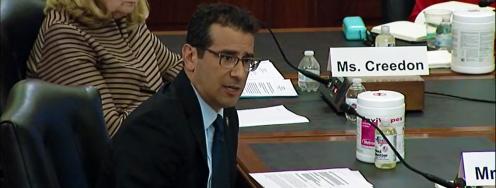Trouble Fulfilling U.S. Commitments Under Interim Iran Deal
On the radar: Implementation slow; Deal-making calculus; Iran talks lay groundwork for draft deal; $100 billion sub specs; B61 delays; Air Force nuclear reviews; Why Gulf States should be optimistic; BJP might chance nuclear posture; and Mother Nature forces shutdown of North Korean reactor.
April 8, 2014 | Edited by Lauren Mladenka and Geoff Wilson
Imperiling the deal - “There exists, right now, a problem with one side's obligations not being fulfilled as provided for under the preliminary agreement, known as the Joint Plan of Action, that Iran reached with the United States and its negotiating partners (the P5+1) last November,” writes Paul Pillar in The National Interest. “This lack of fulfillment endangers the process of negotiating a final agreement. It is an understandable source of consternation to the other side, which will increasingly doubt the first side's ability and willingness to make good on its commitments, including in any final deal.”
--“[The] current problem in implementing the agreement involves another part of the P5+1's side of the deal, not Iran's side. Specifically, it involves the unfreezing in installments of a small portion ($4.2 billion out of an estimated $100 billion) of the Iranian money that already was earned from prior oil sales and is sitting in non-Iranian banks. Iran has been unable to withdraw much of the money that it was supposed to have gained access to by now. It appears the problem is not direct violation of the agreement by the U.S. Treasury or any of the other governments involved. Instead, the banks that are to handle the funds are so deathly afraid of running afoul, however inadvertently, of any continuing sanctions that Treasury is enforcing that they have not made the money move.”
--“The current problem also underscores how much work—political, not just administrative—on the U.S. side remains to be done to prepare for the undoing of sanctions that will be part of any final agreement, and that necessarily will be substantially greater than the minor sanctions relief in the JPA. Members of Congress are still talking about piling on more sanctions when they ought to be discussing how to take sanctions off the pile. We have already seen how hard it is to redirect the sanctions machine. Aircraft carriers do not turn around on a dime, and neither do sanctions, especially ones as complicated and extensive as the ones on the Iranian pile. Even if the more optimistic projections of when a deal will be struck in Vienna do not prove true, it is not too soon for Congress and the administration to be working diligently on this and for it to be a subject of public discussion.” Full article here. http://bit.ly/1jYX7K8
Formula for success - Prospects for a final Iran nuclear “deal this summer are rising, with official pronouncements now being matched by outside expert assessments,” writes Joe Cirincione of Ploughshares Fund in Defense One. “Among us, the list of what’s required for a deal with Iran has moved dramatically from unrealistic demands that Iran dismantle its entire nuclear infrastructure to outlines of arrangements that could verifiably limit Iran’s nuclear program to purely peaceful use… Such a deal will likely not be based on some magic number of allowed centrifuges or kilos of uranium. But there is a formula that could guide negotiators to a solution that all the parties could support.
--“Balancing limits on capabilities with increased transparency and assured penalties for violations could give nations confidence that Iran’s program was so confined, monitored and understood that it could not quickly or secretly turn to producing a nuclear weapon. While the talks are complex, the basic facts are well understood and can be broken down into ten key issues. Confidence could be viewed as a function of the relative value of these various issues. The equation could be express as follows: C = f (QC + CC + LC + QLEU + Pu + R&D + V + HPMD + D + PW), with Confidence (C) being a function of Quantity of centrifuges (QC), Capability of centrifuges (CC), Locations of centrifuges (LC), Quantity of low-enriched uranium (QLEU), Plutonium production capabilities (Pu), Research and development on advanced technologies (R&D), Verification of all of Iran’s activities (V), Disclosure of the history of programs with possible military dimensions (HPMD), duration of the deal (D), and political willingness of the parties to enforce the deal (PW).”
--“All parties are committed to reaching a comprehensive agreement by the declared deadline of July 20. Officials from the negotiating states believe that they can meet that goal, but the bargaining will be tough. It will likely go down to the wire, and perhaps require some time extensions. Having a formula for success could help the negotiators keep their eyes on the prize in the turbulent weeks ahead.” Read the full article here. http://bit.ly/1e7OPzA
Great expectations - “With nuclear talks set to resume in Vienna on Tuesday, the Obama administration says it is convinced it can conclude an agreement to limit Iran's nuclear program by the July 20 target date despite significant political hurdles,” write Jay Solomon and Laurence Norman in The Wall Street Journal. "I'm absolutely convinced that we can [meet the July 20 deadline], though the real issue is…about the choices that Iran has to make, and some of them are very difficult," said a senior U.S. official. "We are on pace with that work plan, looking toward beginning drafting in May." Full article here. http://on.wsj.com/1gHFFEo
New boomer specs - “The Navy has completed the specifications and has set the length for its next generation nuclear ballistic missile submarine,” Sam LaGrone reports for USNI News. “The Ohio-class Replacement Program boats (ORP, formerly known as SSBN(X)) of 560 feet about the same length as the Ohio-class (SSBN-726) but with eight fewer missile tubes than the service’s current boomers… [while] the extra length — in relationship to the number of missile tubes — was included in the design to improve on stealth, cost and maintainability of new SSBNs.”
--“The more than 20,000 ton submarine will be the largest submarine the Navy has ever constructed… [and] The latest Navy figures estimate the boomers will cost $110 million a year to operate with a second through twelfth ship with an average cost of $5.36 billion a hull — both in 2010 dollars. The Navy’s goal — set by the Office of the Secretary of Defense — is for $4.9 billion per boat...the $100 billion program will be among the most expensive shipbuilding undertakings in the Navy’s history… The Navy plans to start construction of the first ORP in 2021 with a first planned patrol to start in 2031.” Read the full report here. http://bit.ly/1g25eUM
B61 delays - “U.S. Defense Department experts see a danger of delays in work on a key nuclear-bomb component under development at multiple federal agencies,” Diane Barnes reports for Global Security Newswire. “Preparation of the new B-61 gravity bomb ‘tail kit’ is currently proceeding on schedule, but the project's time line faces ‘risks’ from separate work under way at the Defense and Energy departments, according to the Pentagon's Systems Engineering office.” Read the full story here. http://bit.ly/1gHGpJY
GCC to benefit - “Today, diplomats from Iran and the P5+1 will meet to continue negotiations over Iran’s disputed nuclear programme,” writes Trita Parsi in
--“Eliminating the path to proliferation in Iran would also halt a nuclear arms race in the region. These are obvious benefits that should not be easily dismissed. Equally important is that a deal also would prevent war with Iran. Short-sighted analyses claiming that ‘cutting the head of the snake’ is a risk worth taking are sorely mistaken. In fact, the consequences of a US military confrontation with Iran, where Tehran would seek an edge by expanding the theatre to war to engulf the entire region, are particularly grave for the GCC states.” Read the full article here. http://bit.ly/1swa8yK
Reviewing the review - “Service leaders took an assessment last year of the nuclear Air Force as an encouraging thumbs-up. Yet, in the months that followed, signs emerged that the nuclear missile corps was suffering from breakdowns in discipline, morale, training and leadership,” Robert Burns writes in a piece for the AP. “The former Air Force chief of staff who signed off on the 2013 report is now being asked to dig for root causes of problems that Defense Secretary Chuck Hagel says threaten to undermine public trust in the nation's nuclear arsenal.”
--“The Air Force may have taken an overly rosy view of the report — it was not uniformly positive — by a Pentagon advisory group headed by retired Gen. Larry Welch. The study described the nuclear Air Force as ‘thoroughly professional, disciplined’ and performing effectively. The inquiry itself may have missed signs of the kinds of trouble documented in recent months in a series of Associated Press reports. In April 2013, the month the Welch report came out, an Air Force officer wrote that the nuclear missile unit at Minot Air Force Base, N.D., was suffering from ‘rot,’ including lax attitudes and a poor performance by launch officers on a March 2013 inspection. Read the full piece here. http://abcn.ws/1eonyn6
India’s nuclear doctrine - “The Bharatiya Janata Party (BJP), widely tipped to form the next government, pledged on Monday to revise the country's nuclear doctrine, whose central principle is that New Delhi would not be first to use atomic weapons in a conflict,” write Sanjeev Miglani and John Chalmers in Reuters Richard Boucher, former U.S. assistant secretary of state for South and Central Asia, “said scrapping the no first strike policy would ‘not (be) a smart move’ by the BJP. ‘What does it do for India? Nothing really, although it would introduce a small, probably destabilising, element in the calculations of nuclear adversaries. In fact, the threats to India - terrorist groups and conventional border disputes - can't be dealt with by nuclear threats. India's nuclear strategy ain't broke, so don't fix it.’" Read the full story here. http://reut.rs/PYHNC5
Water woes - “North Korea may have temporarily shut down a plutonium reactor earlier this year as it grappled with water supply problems that could threaten the safety of its nuclear complex,” reports Matthew Pennington for AP. “U.S.-Korea Institute at Johns Hopkins School of Advanced International Studies says recent commercial satellite imagery show the recently restarted reactor may have been temporarily shut down or operated at a lower power level for repairs after flooding caused [a nearby] river to change course.” Get the full story here. http://abcn.ws/1sw8E7D
Quick-hits:
--“U.S. Senators Press for Hard Line Over Reported Iran-Russia Deal” by Patricia Zengerle in Reuters. http://reut.rs/1g1Saik
--“Germany Summons North Korean Envoy to Protest Against Nuclear Test” by Erik Kirschbaum in Reuters. http://reut.rs/1mVGUrU
--“Navy Seeks Sub Replacement Savings: From NASA Rocket Boosters to Reused Access Doors” by Sydney Freedberg in Breaking Defense. http://bit.ly/1hos9eV
Events:
--“Fiscal Year 2015 Atomic Energy Defense and Nuclear Forces.” Hearing from the House Armed Services Subcommittee on Strategic Forces. April 8 from 3:30-5:30. Webcast available on the committee website. http://1.usa.gov/1mUx4na
--Fourth anniversary of the signing of the New START nuclear arms reduction treaty by President Obama and Russian President Dmitry Medvedev. Prague. The treaty reduces the maximum number of deployed strategic nuclear weapons by the United States and Russia from 2,200 to 1,550 each.
--“National Nuclear Security Administration management of its National Security Laboratories and the status of the Nuclear Security Enterprise.” Hearing from Senate Armed Services Subcommittee on Strategic Forces Subcommittee. April 9 at 2:30. Webcast available on the committee website. http://1.usa.gov/1qeqJVP
--“The Iranian Nuclear Talks and Regional Arms Control." Discussion with Sameh Aboul-Enein, Ziad Ali Khalil Abu Zayyad, Shlomo Brom, and Hillel Schenker. April 10 from 12:00-2:00 at the At Women’s National Democratic Club, 1526 New Hampshire Ave., NW, Washington. RSVP here. RSVP by email to fes.temp2@fesdc.org
--“Challenges to Further Nuclear Arms Reduction.” Discussion with Dennis Gromley, Götz Neuneck, and Nikolai Sokov. April 14 from 2:00-3:30 at Brookings Institution, Saul/Zilkha Rooms, 1775 Massachusetts Ave., NW, Washington. RSVP here. http://bit.ly/1jnQbFs
--“Making a Difference: Faith Communities Speak to the Humanitarian Impact of Nuclear Weapons.” Discussion with Andrew Kanter, Daryl Kimball, and eight other speakers. April 24 from 9:30-4:00 at the U.S. Institute of Peace, 2301 Constitution Ave., NW, Washington. http://conta.cc/1ssfg70



